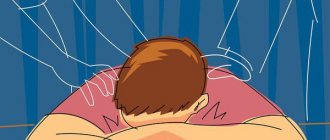Delirium tremens occurs in chronic alcoholics after approximately 7-10 years of regular drinking. A person with delirium tremens experiences hallucinations and increased anxiety . He may lose consciousness frequently and for a long time. This is a serious and very life-threatening condition that requires immediate assistance from specialists. Attacks may recur if a person continues to drink alcohol. Alcoholic delirium can lead to death or irreversible mental changes, so you shouldn’t let the situation get worse.
Causes of alcoholic delirium
Delirium tremens has a rather complex mechanism of occurrence. If a person drinks alcohol for a long time, toxins spread throughout all tissues, both physical health and mental health suffer. If a person drank to the point of delirium tremens, medical help cannot be avoided. Under the influence of alcohol, changes occur in the brain; reactions of excitation and inhibition begin to increase. Due to toxic damage to the central nervous system, a person’s mood changes sharply, and their emotional state becomes unstable.
factors contribute to the occurrence of delirium :
- Abrupt withdrawal, withdrawal syndrome. Delirium usually occurs in patients who have been drinking for a long time and then suddenly stop drinking. Delirium tremens appears 2-5 days after the cessation of binge drinking.
- Operations performed. Surgery weakens the body. Drinking alcohol increases the risk of delirium delirium.
- Heredity. According to experts, family history also plays a role. If parents drank a lot, the child's risk of developing alcoholism increases.
- Long-term alcohol intake. The longer the patient has been drinking alcohol, the more dangerous it is to abruptly quit it. The likelihood of delirium tremens increases.
The main cause of delirium is alcoholism . It often appears in alcoholics with stage 2 or 3 addiction. If the patient has already experienced 2-3 attacks of delirium tremens, they speak of the appearance of atypical delirium, which in symptoms is very similar to schizophrenia.
It is important not to confuse delirium and alcoholic hallucinosis. The second is less common in alcoholics and is not so life-threatening. The mortality rate in this case is much lower than with delirium tremens. The patient hallucinates , but can still perceive reality, which is not the case with delirium. An alcoholic with delirium tremens does not understand what is happening at all, is in his own world and is completely divorced from reality.
What is it and how long does it last?
Delirium tremens can be characterized as follows: it is a psychotic condition causing tremors, hallucinations, restlessness and disorientation . The question of how long symptoms last is one that often arises among people who want to stop drinking and get on the path to sobriety. In fact, sometimes this is the reason why a person is afraid to quit drinking.
An alcoholic may experience severe hallucinations.
However, there is no clear time frame. Symptoms may appear for only 24 hours , and after prolonged alcohol intoxication they may not subside for a week. The amount of time usually depends on how long a person has been abusing alcohol and how much he drank.
What causes delirium? It is generally accepted that excessive alcohol consumption interferes with the body's ability to regulate the neurotransmitter GABA (gamma-aminobutyric acid, which inhibits the nervous system). Therefore, the brain can go into overly dangerous states that lead to the symptoms described above, as well as further complications such as seizures.
Stages of delirium tremens
Delirium tremens develops gradually. Hallucinations and delusions do not appear abruptly or unexpectedly , so it is quite possible to identify delirium before it reaches its peak. Typically the following stages are distinguished:
- The person has a severe headache and signs of intoxication appear: nausea, vomiting. His speech becomes incoherent and incomprehensible, increased sweating, tremors occur, and convulsions are possible.
- At the next stage, the patient cannot sleep or sleeps very little and poorly, and anxiety continues to increase. He begins to sense danger, talk about how he (or his loved ones) will die soon, and fear catastrophes. Visual and auditory hallucinations appear, the temperature rises, and the eyes become red.
- This is the peak of delirium delirium. This life-threatening condition occurs 3-4 days after quitting alcohol. Hallucinations become stronger. The patient talks to non-existent people, sees animals, devils or mythical creatures, feels bites or crawling insects. He is completely divorced from reality and does not understand what is happening around him.
Acute psychosis requires medical attention. It does not go away on its own. It must be remembered that there are no uniform signs of delirium. In men and women, it proceeds and begins differently depending on the stage of alcoholism, the duration of the binge and the general condition of the body. There are several types of delirium, which are accompanied by different symptoms. For example, occupational delirium begins with panic and anxiety, but then they disappear. A person begins to perform some actions related to his professional activity because he thinks that he is at work.
Classic shape
Fever is accompanied by a triad of symptoms by which the disease can be easily differentiated from others:
- confusion;
- hallucinations, delusions;
- tremor (shivering).
The disorder usually develops in the evening and begins with a feeling of restlessness, causeless anxiety. If the patient can sleep, he has nightmares.
Only an experienced psychiatrist can recognize alcohol psychosis by identifying the signs characteristic of an altered state.
- At the first stage, the patient’s mood quickly changes: from a cheerful state he moves to a depressed one, from lethargy and relaxation to euphoria. He faces depersonalization and often cannot navigate in space. According to the scheme described by doctors back in 1866, the patient’s emotional reactions accelerate, and facial expressions become richer. Bright light seems unpleasant to him, and loud noises make him flinch.
- At the second stage, visual hallucinations appear. A person can see images that are made up of shadows on a wall or in a wallpaper pattern, and also see distinct visual images immediately after waking up or at the moment of falling asleep. Dream and reality mix, a person begins to see pictures reminiscent of dreams, not only in sleep, but also when closing his eyes. After waking up, addicts cannot understand what was a dream and what was reality.
- At the third stage, a person physically cannot fall asleep even for a short time. He experiences auditory, visual, tactile, gustatory and other hallucinations. If you give the patient a blank sheet of paper, he will see an image or text on it, and instead of silence in the telephone receiver, he will hear speech.
Most people associate delirium with aggressive behavior. But this impression is wrong : a person can be in high spirits, communicate with other people, tell funny stories that are partly incoherent and full of illogical details. Also, the patient often expresses tenderness and love for others and the world, but after a few minutes he withdraws into himself, becomes gloomy and thoughtful.
The exit from the state usually occurs after a deep and long sleep. After waking up, the person partially remembers what happened to him during the attack. Sometimes he continues to hallucinate when focusing on shiny objects.
In 80% of cases the syndrome does not last long. However, in some patients, fever occurs in waves, with alternating deterioration and improvement of well-being. The prognosis depends on the specific form.
Consequences
The severity of the condition is also determined by the presence of chronic diseases in the patient. They are all getting worse. If the patient had asthma, he begins to choke, if there is an ulcer or gastritis, he feels pain in the abdomen. Delirium should only be treated in a hospital under the supervision of doctors.
Delirium tremens can lead to alcoholic neuropathy. The patient experiences muscle pain and numbness. Damaged nerves often never recover, affecting quality of life and career.
Some of the severe consequences of delirium include :
- Damage to the kidneys and liver;
- Disorders of the heart and lungs;
- Brain swelling;
- Chronic psychosis;
- Suicide;
- Murder and other crimes.
The consequences can be very dangerous , even fatal. There is a disruption in the functioning of internal organs and metabolism. Around 2-3 days the body begins to suffer from severe dehydration.
As a result of chronic alcoholism, leading to delirium tremens, the functioning of the pancreas is disrupted, which can lead to diabetes mellitus. A person in a state of delirium has poor -control . He can harm loved ones, injure himself, and even decide to commit suicide.
Please note the data below from the official website of the Federal State Statistics Service:
| 2006 | 2011 | 2016 | 2017 | 2018 | 2019 | |
| Total number of patients diagnosed with alcoholism and alcoholic psychoses taken under observation, thousand people | 209,2 | 153,9 | 103,6 | 95,1 | 81,8 | 77,5 |
| per 100,000 population | 147,0 | 107,8 7 | 70,7 | 64,7 | 55,7 | 52,8 |
| of which alcoholic psychosis total, thousand people | 74,2 | 47,5 | 30,0 | 25,5 | 19,6 | 18,5 |
| per 100,000 population | 52,1 3 | 33,2 2 | 20,5 | 17,3 | 13,3 | 12,6 |
Mandatory procedures
In most cases, patients with delirium tremens are taken to a psychiatric hospital, where special treatment is provided. This is also necessary so that he cannot harm himself (if the cloudiness occurs, a person may even jump out of the window) or other people. In order for the symptoms to completely subside, careful treatment under constant supervision is required.
First of all, patients are given drugs that stop attacks (sibazon solution, sodium hydroxybutyrate, etc.). Then the body is detoxified, the remaining alcohol is removed from the blood, breathing is stabilized and, with the help of special tranquilizers, drugs and vitamins, the water-electrolyte balance is normalized and metabolism is restored.
The main task of doctors is to suppress psychotropic disorder and restore normal sleep in the patient.
Symptoms of delirium delirium
To help a person, you need to know the signs of alcoholic delirium and recognize them in time. In a patient with delirium tremens, all chronic diseases become aggravated, the mood changes sharply from euphoria to depression, and then hallucinations .
There are several symptoms of extreme delirium:
- Physical weakness. The patient cannot stand on his feet and has difficulty moving.
- Severe shortness of breath, fever. The patient's temperature rises greatly (up to 40 degrees), chills appear, it is difficult to breathe or breathing becomes shallow.
- Problems with coordination. Your arms and legs are trembling, it is difficult to maintain a firm gait.
- Lack of normal perception of reality. A person cannot soberly assess the situation, express his thoughts and perceive someone else’s speech.
- Excitation. A person with delirium has difficulty concentrating and paying attention to anything.
- Increasing symptoms. Without treatment, every hour a person’s condition becomes more unstable and severe.
It is advisable to call an ambulance at the initial stage. The sooner you can help the patient, the lower the likelihood of irreversible consequences.
Development of withdrawal syndrome
Withdrawal syndrome may appear within a few hours after the last drink. The main stages and possible complications are listed below. Please keep in mind that these are general cases and there may be exceptions.
Withdrawal symptoms can be deadly.
The first stage of withdrawal involves the onset of minor symptoms, usually subsiding in less than 12 hours after the last drink. These include anxiety, insomnia, nausea, headaches, loss of appetite, sweating, and fast or irregular heartbeat.
12 to 24 hours
During this period of time, tactile, auditory, or visual hallucinations may occur . Visual hallucinations are the most common. For example, a person may see something dangerous outside the window, break the glass and cut himself. The patient may experience a burning sensation, itching or numbness that has no physical cause.
24 to 48 hours
Severe withdrawal attacks most often occur during this period. This can be very dangerous as life-threatening complications can occur. Typically, most symptoms resolve within a maximum of five days , but full recovery may take weeks.
Treatment of delirium tremens
Delirium tremens never goes away on its own. If is neglected , the person may die or be left with chronic mental disorders. To restore the nervous system, you definitely need to contact a specialist. In severe cases, the patient is placed in intensive care.
Treatment for delirium tremens in a hospital includes:
- Detoxification. To alleviate the patient’s condition and speed up recovery, it is necessary to remove the breakdown products of ethyl alcohol from the blood. For this purpose, a dropper is placed, which cleanses the blood and restores electrolyte balance.
- Complete peace . The patient needs to create optimal conditions for recovery. If he shows aggression and tries to harm himself, doctors can fix him until his condition normalizes.
- Constant surveillance . Medical staff will constantly monitor the patient’s health status, monitor pulse and blood pressure in order to provide first aid if necessary.
- Symptomatic therapy . The patient is given antiemetics, hepatoprotectors, anticonvulsants, nootropics, and vascular strengtheners so that the body recovers faster from intoxication.
- Help from psychiatrists . To normalize the patient’s condition, eliminate panic, aggression, and anxiety, psychotropic medications are prescribed. The duration of treatment depends on the severity of the patient's condition.
The patient is constantly monitored . If there is no improvement, the treatment regimen is changed. Patients are in a well-lit room, since twilight and darkness tend to provoke new hallucinations.
It is also advisable to treat alcoholism in order to get rid of the root cause of delirium. If a person continues to drink after treatment, the psychosis is likely to return. The appearance of delirium tremens is already an alarming sign. This means that a person is at that stage of alcoholism when ethanol poses a danger to life. It is advisable not to put off the fight against addiction until later. You can immediately stay in the hospital and undergo treatment for alcohol dependence.
Signs and associated symptoms
Common signs of delirium tremens include nausea, vomiting, body tremors, high blood pressure, abnormal heartbeat (tachycardia), sensitivity to light and noise, intense feelings of anxiety, fear or paranoia, overexcitement, decreased alertness, visual or auditory hallucinations (very common). seeing, hearing or feeling things that are not there), disorientation, confusion and insomnia. These symptoms are dangerous both for the person experiencing them and for those around them.
Can delirium be treated at home?
Delirium tremens usually develops over several days. The first symptoms appear 2-3 days after the end of the binge and intensify. Relatives may suspect something is wrong and call an ambulance . This is the best thing that can be done for the patient. You can’t waste time and wait for the condition to normalize on its own.
The first thing to remember is that it is impossible to get rid of delirium at home without medical help. However, you can alleviate the patient's condition before the doctor arrives. You can use the following recommendations :
- Don't make the patient angry. There is no need to try to prove to him that he is having a seizure or schizophrenia; he is not able to adequately perceive someone else's speech. Slapping him in the face, pouring water on him, and screaming will not help him come to his senses, but will only worsen the situation.
- Do not let the patient leave the house. It is better to hold him until the doctors arrive. If the patient goes outside, he may get lost, freeze, or get hit by a car.
- Do not give him unknown drugs and dubious folk remedies. Be careful with painkillers, sedatives, and sleeping pills. It is advisable to wait for the specialists to arrive. If you decide to give the patient the drug, do not exceed the dosage.
- Never give alcohol. Although delirium occurs due to abrupt withdrawal, alcohol should not be given to the patient. This will not help him wake up, but will only increase intoxication and complicate the work of doctors.
Folk remedies cannot completely restore the damaged nervous system and psyche. Sometimes it is recommended to give a decoction of yarrow, wormwood, and bay leaf. You can add honey to the broth; it speeds up the process of removing toxins. However, you need to know for sure that the patient is not allergic to herbs or bee products.
The sooner you recognize delirium and call a doctor, the more likely it is that the patient's mental state will recover. One of the severe consequences of delirium tremens is Wernicke-Korsakoff syndrome. A person may permanently lose their memory. Changes in the brain become irreversible due to damage to the hypothalamus.
Where do monsters come from?
Alcoholic hallucinosis appeared a long time ago, when there were no works of popular fiction, cinema and television. Then the sources of images were the Holy Scripture and other religious literature, which describes hell and the creatures inhabiting it.
Today's patients have watched horror films and anime, played computer games, so images appear in their heads that Murakami is resting. Stories heard long ago remain in the subconscious and remind of themselves when delirium sets in.
One man said that devils smell like dogs - such vivid hallucinations haunted him. The other not only saw the snakes, but also clearly heard their hissing.
There is a controversial scientific theory that links the emergence of religions to people being in altered states. For example, South American Indians used mescaline and saw, say, a familiar image of a bear, but with two heads or an unusual green color, it could speak in the voice of a familiar person or fly in the sky. If such visions were observed by a shaman, they were perceived categorically, without criticism, and thus, according to some researchers, legends were born and the foundations of religious teachings were laid.
Ethnomycologists Robert Gordon Wasson and his wife Valentina Pavlovna Wasson studied the influence of entheogens, including psilocybin, on the culture of indigenous peoples of America. The couple combined data on mycology with data from other sciences - history, linguistics, mythology, comparative religion. They called the new discipline ethnomycology
.
In a state of altered consciousness, people today often see evil spirits, ideas about which exist in their religions or in folk mythology, and here the ethnic and religious diversity of our country is manifested.
Sometimes those who observe such images consider this to be a manifestation of some kind of chosenness. As a rule, such an experience is associated with drug intoxication, when hallucinations can be of a loyal or even benevolent nature towards the patient. But in the case of alcoholic delirium, the monsters behave aggressively: they threaten, give chase, and try to kill. Here the opposite idea of self-abasement, fair persecution arises: “I did something for which all these monsters were sent to me as punishment.” No matter how uneducated the patients are, no matter how low their intellectual level, sooner or later the moment of criticism comes: they understand that the condition they are experiencing is associated with alcohol consumption. But this awareness rarely becomes a reason to quit drinking.
Breakthrough of devils through the ethereal field
In the 1990s, when Russia was experiencing a renaissance of occultism in all its diversity, Chelyabinsk psychiatrist Nikolai Pravdin spoke at a medical conference in Yekaterinburg with a report on delirium, the essence of which boiled down to the following: strong alcohol, with its powerful negative energy, thins the human etheric field and also changes the frequency of electrical impulses in nerve cells, so the human eye receives additional perceptual capabilities. As a result, alcoholics begin to see otherworldly entities, and those, taking advantage of their weakness, surround them, like vampires creeping up on a potential victim - this is “delirium tremens.”
Why should you contact the Light Line clinic?
Delirium tremens can lead to serious irreversible mental disorders. If your friend or relative is in a difficult situation, our doctors are ready to help. To avoid serious complications, contact the Bright Line clinic immediately. We have been working for more than 13 years and have managed to earn the trust of our patients.
Our main advantages :
- Own vehicle fleet and emergency assistance at home;
- Effective methods and high-quality drugs;
- Only reliable, qualified specialists (psychiatrists, resuscitators, narcologists);
- Availability of a license;
- Guarantee of complete anonymity;
- Affordable prices for services.
We offer both delirium delirium care and alcohol addiction treatment. At the clinic you can get coded , get psychological support, and undergo treatment in a hospital. Drug and psychotherapeutic treatment will help avoid relapses in the first year of quitting alcohol (the most difficult time for an alcoholic). We do not leave patients after discharge. You can always get advice by phone, attend trainings or make an appointment.
Editor of the article: Rytina Marina Leonidovna
Causes and risk factors
The only reason for the development of delirium tremens is the abuse of alcoholic beverages that lasts for many years. Factors that increase the risk of alcohol-induced delirium include:
- consumption of low-quality alcohol (pharmacological preparations and technical liquids containing alcohol and its surrogates);
- long drinking bouts;
- expression of pathological changes in internal organs, primarily in the liver;
- history of brain diseases and traumatic brain injuries.
The only cause of delirium tremens is alcoholism lasting many years
The pathological mechanism of the development of delirium tremens has not yet been fully studied. It is assumed that the main role in the occurrence of acute psychosis is played by metabolic disorders and long-term chronic intoxication of brain tissue.










